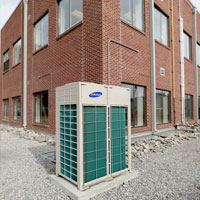HVACs compared using two-story flexible research platform

Although variable refrigerant flow (VRF) heat pumps have several advantages, higher initial costs and difficulty in quantifying those benefits serve as deterrents to their widespread use. ORNL’s two-story flexible research platform (FRP-2), however, provides a solution that enables researchers to characterize real-world performance. FRP-2 is an instrumented, unoccupied, two-story small office building with 10 thermal zones and several separate multi-zone HVAC systems installed. By rotating between HVAC systems weekly—operating each during cold, hot, and mild outdoor conditions—and controlling the occupant impact on energy use to be the same for each HVAC system through emulation, apples-to-apples performance for each HVAC system type can be directly measured.
Using this methodology, ORNL measured the performance of an all-electric VRF system and an all-electric direct expansion -cooling rooftop unit, with variable air volume terminals in each zone with electric resistance reheat coils (RTU/VAV/reheat). The performance of the VRF system was characterized with standard thermostat control and with enhanced control algorithms known as the comfort control method (CCM). The VRF system outperformed RTU/VAV/reheat, providing heating and cooling savings of 74 percent and 17 percent, respectively, with standard thermostat control, and 80 percent and 26 percent savings, respectively, with CCM control. Details were published in a conference paper for the ASHRAE June 2015 Annual Meeting. This work was sponsored under a Work for Others agreement with Samsung.

